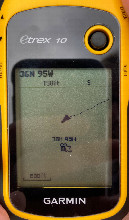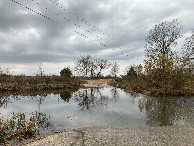|
United States : Oklahoma
3.2 miles (5.1 km) SW of Moodys, Cherokee, OK, USA
Approx. altitude: 254 m
(833 ft)
([?] maps: Google MapQuest OpenStreetMap topo aerial ConfluenceNavigator)
Antipode: 36°S 85°E
Accuracy: 65 m (213 ft)
Quality:
Click on any of the images for the full-sized picture.
| 36°N 95°W (visit #2) |
 (visited by Michael G) 27-Nov-2024 -- With plans to be in eastern Oklahoma for Thanksgiving, I couldn't pass up the opportunity to attempt 36N 95W. Having last been visited 24 years ago, it was certainly overdue for a checkup! However, I can understand why it'd been so long — satellite imagery (and Richard Rutledge's report) makes it clear that the point lies on private property near a home: not something that'd be smart to attempt without speaking to a landowner. This was a bit offputting for me, not yet accustomed to explaining the abstruse concept of "latitude/longitude degree confluences" to strangers. However, I figured it would be good to leave my comfort zone a little and decided to give it a shot; even an incomplete visit would make for a worthwhile adventure and an interesting story. I began my approach to the area from the southwest, driving the length of OK 80 from Fort Gibson (the oldest town in Oklahoma) to Hulbert. The stretch along the Fort Gibson Reservoir was a very pretty, winding road (although fairly rough in spots; at one point it felt like my car almost got air time). Scenic as it was, that segment was largely (and happily) empty of other cars; some locals I know told me that it's typically bypassed in favor of more efficient county roads. It was only about 20 minutes to the confluence after reaching Hulbert, via OK 51 to Tahlequah (a much faster, straighter highway). While traffic didn't become heavy per se, the roads from here on were a little busier than I'd anticipated, particularly on OK 82 north of Tahlequah. Maybe a lot of people were making Thanksgiving Eve grocery runs? Anyway, 36N 95W is about 6 miles north of said town, and very soon I was turning onto Red Fuller Road, along which the property in question was located. After pulling into the driveway, I approached the house and saw the property owner working in the garage. He didn't seem perturbed when I explained my mini-mission, and informed me that the confluence fell outside of his land's boundary. The actual owners of 36N 95W's spot resided in a house visible about a half mile away, on a hill. Fortunately I knew I'd be able to get within 100 meters without crossing into this neighboring parcel — now with permission from the landowner I'd spoken to, I opted to make my nearest approach to the confluence from his side of the fence. It was a quick stroll to the property line, marked by a barbed wire fence and some trees. I arrived at my target meridian and gazed south toward 36N 95W from about 60 meters away; there were more than a few cattle scattered throughout the field, which could've made a zero-meter visit a bit sketchy even if I'd been allowed over there. As it was, I felt perfectly satisfied zeroing out one of the coordinates. The field looked like many of the others I'd seen along my way to the area: a nice unassuming slice of northeastern Oklahoma. The weather was appropriately dreary for late November but not too chilly (yet), about 57°F (14°C); within the previous hour the winds had shifted to northerly, a sign that a cold front had just rolled through. Although it's almost been a quarter-century since the last visit to 36N 95W, I don't think much has changed in the immediate area (other than land ownership). The previously mentioned house on the hill didn't exist in 2000 based on historical satellite imagery, but otherwise the landscape is probably about the same as it had been then. I returned to my vehicle, thanked the landowner once more, and departed west on Red Fuller Road. I encountered the low water crossing of Fourteenmile Creek just as Richard Rutledge had done 24 years ago, then got back on the highway. Feeling hungry, I drove back to Tahlequah for a late lunch at Braum's — mission accomplished! |
| All pictures |
| #1: The field containing 36N 95W, located on the far left of this photo #2: Looking south, directly toward the confluence #3: Looking west from closest point I could get #4: Looking north #5: Looking east #6: Zeroes on the longitude! #7: About 200 feet away #8: Fourteenmile Creek #9: Low water crossing ALL: All pictures on one page |









![Visit #1: [20-Aug-00] Visit #1: [20-Aug-00]](/us/ok/n36w095/preview.jpg)